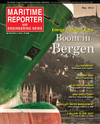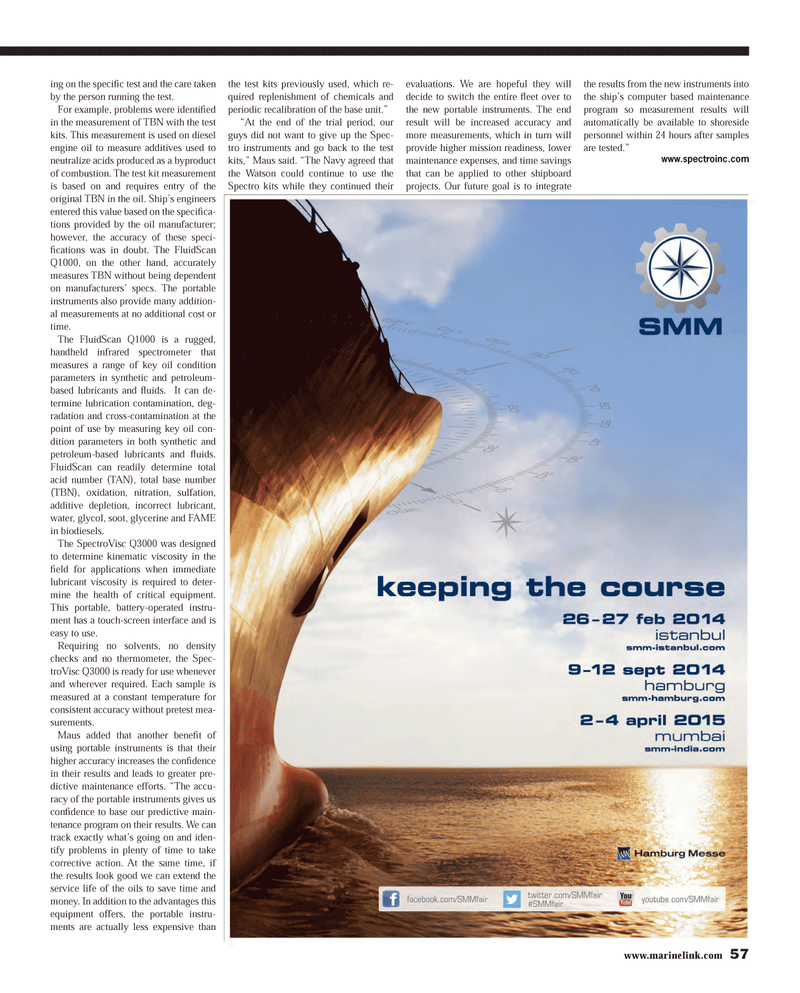
Page 57: of Maritime Reporter Magazine (May 2013)
Energy Production & Transportation
Read this page in Pdf, Flash or Html5 edition of May 2013 Maritime Reporter Magazine
www.marinelink.com 57ing on the speciÞ c test and the care taken by the person running the test.For example, problems were identiÞ ed in the measurement of TBN with the test kits. This measurement is used on diesel engine oil to measure additives used to neutralize acids produced as a byproduct of combustion. The test kit measurement is based on and requires entry of the original TBN in the oil. Ship?s engineers entered this value based on the speciÞ ca-tions provided by the oil manufacturer; however, the accuracy of these speci- Þ cations was in doubt. The FluidScan Q1000, on the other hand, accurately measures TBN without being dependent on manufacturers? specs. The portable instruments also provide many addition-al measurements at no additional cost or time. The FluidScan Q1000 is a rugged, handheld infrared spectrometer that measures a range of key oil condition parameters in synthetic and petroleum-based lubricants and ß uids. It can de- termine lubrication contamination, deg-radation and cross-contamination at the point of use by measuring key oil con-dition parameters in both synthetic and petroleum-based lubricants and ß uids. FluidScan can readily determine total acid number (TAN), total base number (TBN), oxidation, nitration, sulfation, additive depletion, incorrect lubricant, water, glycol, soot, glycerine and FAME in biodiesels. The SpectroVisc Q3000 was designed to determine kinematic viscosity in the Þ eld for applications when immediate lubricant viscosity is required to deter- mine the health of critical equipment. This portable, battery-operated instru-ment has a touch-screen interface and is easy to use. Requiring no solvents, no density checks and no thermometer, the Spec- troVisc Q3000 is ready for use whenever and wherever required. Each sample is measured at a constant temperature for consistent accuracy without pretest mea-surements.Maus added that another beneÞ t of using portable instruments is that their higher accuracy increases the conÞ dence in their results and leads to greater pre-dictive maintenance efforts. ?The accu- racy of the portable instruments gives us conÞ dence to base our predictive main- tenance program on their results. We can track exactly what?s going on and iden- tify problems in plenty of time to take corrective action. At the same time, if the results look good we can extend the service life of the oils to save time and money. In addition to the advantages this equipment offers, the portable instru- ments are actually less expensive than the test kits previously used, which re-quired replenishment of chemicals and periodic recalibration of the base unit.? ?At the end of the trial period, our guys did not want to give up the Spec-tro instruments and go back to the test kits,? Maus said. ?The Navy agreed that the Watson could continue to use the Spectro kits while they continued their evaluations. We are hopeful they will decide to switch the entire ß eet over to the new portable instruments. The end result will be increased accuracy and more measurements, which in turn will provide higher mission readiness, lower maintenance expenses, and time savings that can be applied to other shipboard projects. Our future goal is to integrate the results from the new instruments into the ship?s computer based maintenance program so measurement results will automatically be available to shoreside personnel within 24 hours after samples are tested.?www.spectroinc.com MR #5 (50-57).indd 57MR #5 (50-57).indd 575/2/2013 3:06:53 PM5/2/2013 3:06:53 PM

 56
56

 58
58
